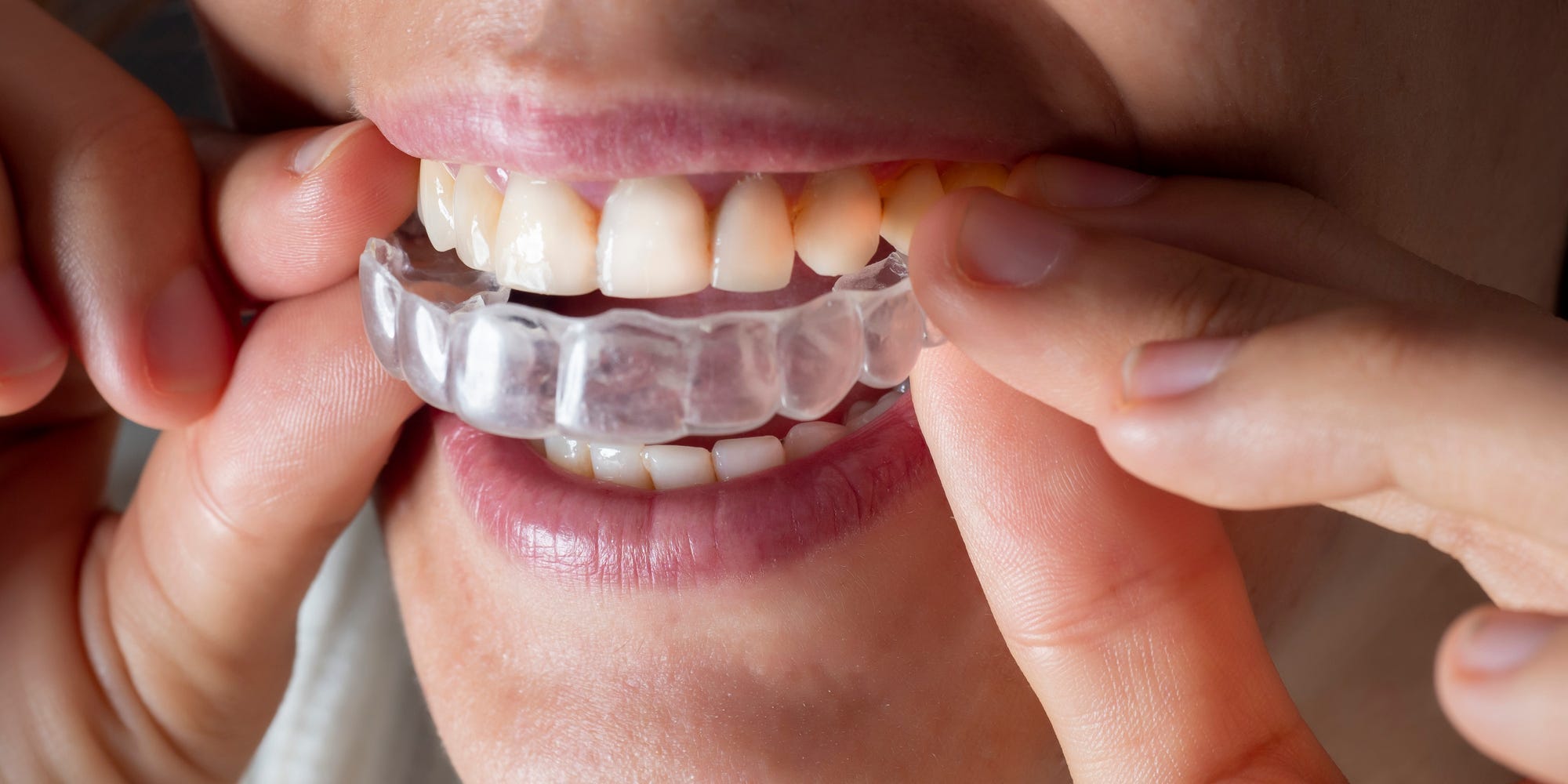
Javier Zayas Photography/Getty Images
- Braces are significantly less expensive than Invisalign.
- However, Invisalign is less painful and noticeable than braces.
- Both Invisalign and braces are effective at realigning your teeth and improving your bite.
- Visit Insider's Health Reference library for more advice.
Wire braces and Invisalign are two treatment options to straighten crooked or misaligned teeth. Braces work by pulling your teeth in a straight line using a metal wire over time. Meanwhile, Invisalign straightens your teeth through a series of clear aligners that slowly shift your teeth into the correct position.
Choosing between the two can be a difficult decision as they each vary in cost, comfort, and appearance. To help you decide which option is right for you, we spoke to two orthodontists about the differences between braces and Invisalign.
Braces are cheaper than Invisalign
The cost of Invisalign ranges from $3500 to $9000. Meanwhile, braces tend to cost between $2500 to $6000.
Dental insurance usually covers some of these costs, however, the amount depends on the provider.
"Insurance plans tend to provide some helpful coverage, but rarely pay the largest part of the total pricing," says Ray McLendon, DDS, the founder of Clear Choice Orthodontic Associates in Houston, Texas.
Both are effective, but Invisalign requires more effort
Braces and Invisalign are equally effective at straightening teeth and both require checkups with your orthodontist every six to ten weeks.
However, for Invisalign to work, the aligners have to be worn at least 20 to 22 hours each day.
Unlike braces - which can't come off without a dental procedure - Invisalign can be removed at any time. If those with Invisalign don't wear the aligners as prescribed, their teeth can shift which means their treatment plan could change or be prolonged.
For this reason, the choice really comes down to lifestyle and compliance.
"Invisalign is more convenient for many people. However, we do have some patients that are honest with us and themselves and say they know they won't wear the aligner all the time and would rather just wear braces," says Vladimir Tabakman, DDS, MS, an orthodontist who practices at Houston Orthodontist Specialists in Houston, Texas.
They both last about the same amount of time
How long you are using Invisalign or wire braces depends more on the original state of your teeth and your goals than which tool you use, says Mclendon.
McLendon explains that short treatment plans usually mean only straightening a few front teeth, which can be accomplished in about six months or less with both braces and Invisalign. As issues become more extensive, treatment times increase and can run between one or two years.
"Orthodontists don't just deal with tooth alignment, we also deal with skeletal or jaw misalignment issues that require a lot of adjustment and time," says Tabakman.
Invisalign is less painful
Invisalign tends to be more comfortable than braces because they aren't made of metal and it applies a gentler pressure onto your teeth to move them.
"Most patients have never experienced having metal in their mouth before wearing braces and sometimes people experience poking or discomfort that is generally avoided with Invisalign aligners," says Tabakman.
Braces and Invisalign both work by applying pressure onto the teeth to straighten them.
"With Invisalign, forces are applied from the aligner on the outside of the tooth through the plastic, whereas with braces the forces on the teeth come from a wire that runs through small brackets that are glued to the individual teeth during the treatment," McLendon explains.
The metal wires on braces are tightened every four to six weeks, unlike Invisalign aligners, which are adjusted every one to two weeks.
"Every time you get wires tightened it adds a lot of pressure to the teeth that gradually goes away in 48 hours," says Tabakman. "Because clear aligners are changed each week, it's a more gradual process and tooth movement is very small, you don't feel as much pressure from wearing them," he says.
Invisalign is less noticeable
With braces, a wire runs across the center of your teeth and is held up by metal brackets on each of your teeth. Invisalign aligners are made of a clear plastic mold that fits directly over your teeth.
Invisalign aligners are also less noticeable than braces. "Wearing clear aligners looks essentially the same as when you're wearing nothing on your teeth," says McLendon.
"Most adults never seek out orthodontic treatment even if they have very crooked teeth, which tells us that the appearance might be enough to deter them from seeking treatment," says McLendon.
Invisalign is better for oral hygiene
The metal wire on braces can make it difficult to floss normally. Also, you should avoid whitening products, like strips, mouthwashes, or even some kinds of toothpaste, while wearing metal braces because it can cause uneven coloration.
Unlike braces, there are fewer restrictions to your oral hygiene routine with Invisalign aligners. "Any orthodontic treatment like brushing and flossing or whitening can be continued with the clear aligners because you can just take them out," says Tabakman.
Also, there are fewer dietary restrictions with Invisalign because you take the clear aligners out when you eat or drink. "There are some dietary restrictions with braces, especially things that are hard or sticky because that could potentially damage the braces," says Tabakman.
Insider's takeaway
When it comes to choosing between Invisalign or braces, consider what option is the best fit for your lifestyle. Invisalign tends to be more comfortable and appear less noticeable. However, they are more expensive, and if you don't wear them enough, they won't work as effectively.
Overall, it's important to clearly communicate your preferences and goals to your orthodontist so they can help you make the right choice.